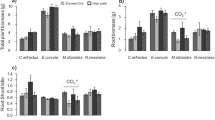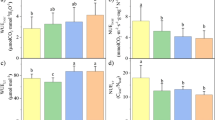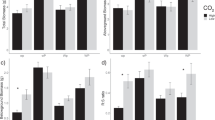Abstract
Background and Aims
The commonly observed trade-off between plant water use efficiency (WUE) and nitrogen use efficiency (NUE) has been attributed to physiological constraints in the leaf. We examined if a similar trade-off can occur between WUE and phosphorus use efficiency (PUE) and if changes in NUE and PUE in response to water and nutrient supply can be related to microbial N and P immobilisation.
Methods
We studied water and nutrient use efficiencies in leaves of four tree species (Eucalyptus sideroxylon, Eucalyptus tereticornis, Casuarina cunninghamiana, and Pinus radiata) that were grown under rainout shelters for 16 months at low and high levels of water and nutrient supply.
Results
Across all four species, WUE increased when water supply was low and nutrient supply was high, while NUE increased when water supply was high and nutrient supply was low. As a consequence, a trade-off was found between WUE and NUE for all four species. In contrast, no trade-off was found between WUE and PUE, likely because PUE and microbial P immobilisation in the soil unexpectedly increased with high nutrient supply.
Conclusions
With variable water and nutrient supply, physiological constraints generate a trade-off between WUE and NUE, but not between WUE and PUE; the latter may have been obscured by microbial control over P supply to plants.







Similar content being viewed by others
References
Aerts R, Chapin F III (2000) The mineral nutrition of wild plants revisited: a re-evaluation of processes and patterns. Adv Ecol Res 30:1–67
Austin AT, Yahdjian L, Stark JM, Belnap J, Porporato A, Norton U, Ravetta DA, Schaeffer SM (2004) Water pulses and biogeochemical cycles in arid and semiarid ecosystems. Oecologia 141:221–235
Brookes PC, Landman A, Pruden G, Jenkinson DS (1985) Chloroform fumigation and the release of soil nitrogen: a rapid direct extraction method to measure microbial biomass nitrogen in soil. Soil Biol Biochem 17:837–842
Brookes PC, Powlson DS, Jenkinson DS (1982) Measurement of microbial biomass phosphorus in soil. Soil Biol Biochem 14:319–329
Brown KR, Courtin PJ, Negrave RW (2011) Growth, foliar nutrition and δ13C responses of red alder (Alnus rubra) to phosphorus additions soon after planting on moist sites. For Ecol Manag 262:791–802
Bünemann EK, Oberson A, Liebisch F, Keller F, Annaheim KE, Huguenin-Elie O, Frossard E (2012) Rapid microbial phosphorus immobilization dominates gross phosphorus fluxes in a grassland soil with low inorganic phosphorus availability. Soil Biol Biochem 51:84–95
Cernusak LA, Winter K, Turner BL (2010) Leaf nitrogen to phosphorus ratios of tropical trees: experimental assessment of physiological and environmental controls. New Phytol 185:770–779
Cernusak LA, Winter K, Turner BL (2011) Transpiration modulates phosphorus acquisition in tropical tree seedlings. Tree Physiol 31:878–885
Cleveland CC, Liptzin D (2007) C:N:P stoichiometry in soil: is there a "Redfield ratio" for the microbial biomass? Biogeochemistry 85:235–252
Cramer MD, Hawkins HJ, Verboom GA (2009) The importance of nutritional regulation of plant water flux. Oecologia 161:15–24
Delgado-Baquerizo et al (2013) Decoupling of soil nutrient cycles as a function of aridity in global drylands. Nature 502: 672–676
DesRochers A, van den Driessche R, Thomas BR (2006) NPK fertilization at planting of three hybrid poplar clones in the boreal region of Alberta. For Ecol Manag 232:216–225
Dijkstra FA, Pendall E, Morgan JA, Blumenthal DM, Carrillo Y, LeCain DR, Follett RF, Williams DG (2012) Climate change alters stoichiometry of phosphorus and nitrogen in a semiarid grassland. New Phytol 196:807–815
Ehleringer JR, Cooper TA (1988) Correlations between carbon isotope ratio and microhabitat in desert plants. Oecologia 76:562–566
Farquhar GD, Richards RA (1984) Isotopic composition of plant carbon correlates with water-use efficiency of wheat genotypes. Aust J Plant Physiol 11:539–552
Field C, Merino J, Mooney HA (1983) Compromises between water-use efficiency and nitrogen-use efficiency in five species of California evergreens. Oecologia 60:384–389
Garrish V, Cernusak LA, Winter K, Turner BL (2010) Nitrogen to phosphorus ratio of plant biomass versus soil solution in a tropical pioneer tree, Ficus insipida. J Exp Bot 61:3735–3748
Gong X, Chen Q, Lin S, Brueck H, Dittert K, Taube F, Schnyder H (2011) Tradeoffs between nitrogen- and water-use efficiency in dominant species of the semiarid steppe of Inner Mongolia. Plant Soil 340:227–238
Güsewell S (2004) N:P ratios in terrestrial plants: variation and functional significance. New Phytol 164:243–266
Helal HM, Sauerbeck DR (1984) Influence of plant roots on C and P metabolism in soil. Plant Soil 76:175–182
Hobbie SE (1992) Effects of plant species on nutrient cycling. Trends Ecol Evol 7:336–339
Jackson ML (1958) Soil chemical analsysis. Prentice-Hall, Inc., Englewood Cliffs, NJ
Jonasson S, Michelsen A, Schmidt IK, Nielsen EV, Callaghan TV (1996) Microbial biomass C, N and P in two arctic soils and responses to addition of NPK fertilizer and sugar: implications for plant nutrient uptake. Oecologia 106:507–515
Jonasson S, Michelsen A, Schmidt IK (1999) Coupling of nutrient cycling and carbon dynamics in the Arctic, integration of soil microbial and plant processes. Appl Soil Ecol 11:135–146
Lambers H, Chapin FS III, Pons TL (2008) Plant physiological ecology. Springer Science, New York, NY, USA
Li F, Kang S, Zhang J, Cohen S (2003) Effects of atmospheric CO2 enrichment, water status and applied nitrogen on water- and nitrogen-use efficiencies of wheat. Plant Soil 254:279–289
Livingston NJ, Guy RD, Sun ZJ, Ethier GJ (1999) The effects of nitrogen stress on the stable carbon isotope composition, productivity and water use efficiency of white spruce (Picea glauca (Moench) Voss) seedlings. Plant Cell Environ 22:281–289
Manzoni S, Porporato A (2007) A theoretical analysis of nonlinearities and feedbacks in soil carbon and nitrogen cycles. Soil Biol Biochem 39:1542–1556
Matzek V, Vitousek PM (2009) N:P stoichiometry and protein:RNA ratios in vascular plants: an evaluation of the growth-rate hypothesis. Ecol Lett 12:765–771
McCulley RL, Burke IC, Lauenroth WK (2009) Conservation of nitrogen increases with precipitation across a major grassland gradient in the Central Great Plains of North America. Oecologia 159:571–581
Olsen SR, Sommers LE (1982) Phosphorus. In: Pace AL, Miller RH, Keeney DR (eds) Methods of soil analysis. Part 2. Chemical and microbiological properties. 2nd edition edn. American Society of Agronomy, Inc., Madison, WI, pp 403–430
Patterson TB, Guy RD, Dang QL (1997) Whole-plant nitrogen- and water-relations traits, and their associated trade-offs, in adjacent muskeg and upland boreal spruce species. Oecologia 110:160–168
Reich PB, Walters MB, Tabone TJ (1989) Response of Ulmus americana seedlings to varying nitrogen and water status. 2 Water and nitrogen use efficiency in photosynthesis. Tree Physiol 5:173–184
Ripullone F, Lauteri M, Grassi G, Amato M, Borghetti M (2004) Variation in nitrogen supply changes water-use efficiency of Pseudotsuga menziesii and Populus x euroamericana; a comparison of three approaches to determine water-use efficiency. Tree Physiol 24:671–679
Sterner RW, Elser JJ (2002) Ecological stoichiometry. the biology of elements from molecules to the biosphere. Princeton University Press, Princeton
Tilman D (1988) Plant strategies and the dynamics and structure of plant communities. Princeton University Press, Princeton
Toft NL, Anderson JE, Nowak RS (1989) Water use efficiency and carbon isotope composition of plants in a cold desert environment. Oecologia 80:11–18
Turner B, Lambers H, Condron L, Cramer M, Leake J, Richardson A, Smith S (2013) Soil microbial biomass and the fate of phosphorus during long-term ecosystem development. Plant Soil 367:225–234
Vitousek PM (1982) Nutrient cycling and nutrient use efficiency. Am Nat 119:553–572
Warren CR, McGrath JF, Adams MA (2005) Differential effects of N, P and K on photosynthesis and partitioning of N in Pinus pinaster needles. Ann For Sci 62:1–8
Warton DI, Duursma RA, Falster DS, Taskinen S (2012) SMATR 3 - an R package for estimation and inference about allometric lines. Methods Ecol Evol 3:257–259
Wright IJ, Reich PB, Westoby M (2003) Least-cost input mixtures of water and nitrogen for photosynthesis. Am Nat 161:98–111
Zhou YC, Fan JW, Harris W, Zhong HP, Zhang WY, Cheng XL (2013) Relationships between C3 plant foliar carbon isotope composition and element contents of grassland species at high altitudes on the Qinghai-Tibet Plateau, China. PLoS One 8:e60794
Acknowledgments
This work was supported by a grant from the Australian Research Council (FT100100779) awarded to F.A.D. and ARC grants (DP0879531 and LP0989881) to D.T.T.
Author information
Authors and Affiliations
Corresponding author
Additional information
Responsible Editor: Harry Olde Venterink.
Rights and permissions
About this article
Cite this article
Dijkstra, F.A., Carrillo, Y., Aspinwall, M.J. et al. Water, nitrogen and phosphorus use efficiencies of four tree species in response to variable water and nutrient supply. Plant Soil 406, 187–199 (2016). https://doi.org/10.1007/s11104-016-2873-6
Received:
Accepted:
Published:
Issue Date:
DOI: https://doi.org/10.1007/s11104-016-2873-6




